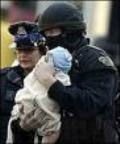
 |
 |
 |
 |
Police Emergency Reviews
EMT What Are They And What Do They Do
EMT: What Are They and What Do They Do?
Most people know what EMTs are, but there are some that are not aware that an EMT is an Emergency Medical Technician, and they have no real understanding of what is required of them, or what EMTs do. They are, in a sense, the first response teams that aid victims during a crisis. More often than not, they are required to assist a patient directly at the scene of the crisis, as well as in an ambulance or other moving vehicle, on the way to the hospital. These emergency workers are most usually on - call during the course of their shifts, which can differ from several 24 hour shifts followed by a couple of days off, to a daily shift often lasting from 12 to 15 hours.
Due to the stress level and often difficult working conditions, it is imperative that these workers maintain a professional, calm and decisive manner at all times. Quick decision making is a must, and leaves no room for slip. In many cases, an EMT is required to treat the victim immediately, these calls for the ability to accurately assess the severity of the problem at collaboration, and determine which treatment is largely friendly. Once the EMT has escorted the victim ( s ) to a medical facility, they are required to report their observations, their plan of treatment up to the moment of arrival, and they sometimes give additional assistance if needed.
There are four levels that are registered with the NREMT ( National Registry of Emergency Medical Technicians ) and these four levels are dependant upon the persons knowledge, skills, and successfully completing the proper certifications and courses for each respective level. The basic capabilities that all EMTs are required to know and have the ability to perform are a few as listed: treat wounds, CPR, administer oxygen, deliver babies, control crummy, advance bone splints and contrary - shock suits, have the capability and knowledge to properly subdue people displaying violent behavior, as well as be able to treat allergic reactions. The abide of the skills are dependant on which level the person is certified to practice. The four levels, as previously mentioned, that are registered with the NREMT are the Pristine Responder, EMT - Basic, EMT - Intermediate, and EMT - Paramedic. The first level EMTs is the level that covers emergency workers, fire fighters, and police, as well as some volunteers. This level includes the most basic of first aid skills, and does require courses for certification, but these are mainly short courses that are for royal first aid only.
EMT - 1 or the EMT - Plain class of EMTs are capable of managing a victims breathing, heart and handle trauma emergencies as well as on - the - spot diagnose the victims condition and make decisions regarding the proper responses for treatment either at the site of the crisis and / or en route to proper medical facilities. The EMT - 2 and EMT - 3 ( EMT - Intermediate ) has the necessary skills to perform the skills required by level EMT - 1 and along protect those skills, they are required to have the ability to administer intravenous fluids as needed, and percussion stopped hearts using defibrillators. Their skills also include the ability to apply their knowledge of advanced airway techniques to assist victims with breathing problems or airway blockages. The highest level, EMT - 4, the EMT - Paramedic are those skilled and certified to perform the most extensive pressure friar to the victim arriving at or being admitted to the medical facility. This level of EMT has the ability, skill, and knowledge to perform all of the previously listed skills as well as minor tracheal surgery, which is inserting a tube into the windpipe of a victim to assist them in breathing if it is necessary. EMT - 4's are certified to administer drugs, and use a myriad of fresh complex medical equipment as well as read electrocardiograms ( EKG's ). All levels of these EMTs are qualified to work as / with police officers, fire fighters, in hospitals or other health care facilities.
 |
 |
 |
Cameras Installed In Police Cars
Emergency Medical Technician Defined
How Understaffed Is Your Local Police And Emergency Department
Teaching The Next Generation To Respect
Police Brutality Have We Punished The Wrong People
General Job Description For A Police Officer
How The Police Protect Your 5th Amendment Rights
PDA
Physiotherapy
Property Taxes
Renting
Security Cameras
Seniors Issues
Weather
Web Video
More Police Emergency Reviews
General Job Description For A Police Officer
... applying for a job as a police officer. The average person has no conception what entails being a police officer and very few people get what is expected of them. This article is written with those of you in brains that is considering a mindset on your local police force. Keep in mind, this is merely ...
Personal Protection For Emergency Technicians
... and infections and can ensure that objects stay facade the eye bearings they belong. Much single protective machinery exists to help protect the individual from the hazards extrinsic there but these are some of the most important items used today. Complete body coverage is also used to prevent injuries ...
... in the police and devouring services alone is enough to make you stop and take another look at this question. There is also the risk tot eh health and well being of the select that could prove to be a problem later on down the road. You can jab to ignore the facts in front of you but that does not mean ...
Emergency Medical Technicians Do You Qualify
... receive their certification for both the EMT - Basic and the EMT - Intermediate are eligible for enrollment and completion of the final level of EMT - Paramedic. The requirements of this level are an additional 750 - 2, 000 hours of training and skills education. This level is the most strenuous, as well ...

|
| Copyright © 2006-2012 Internet Marketing Tools, All Rights Reserved |